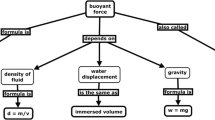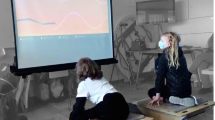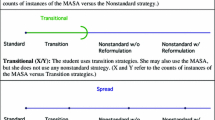Abstract
With limited prior research on young children’s learning of the measurement of mass, the study reported in this paper provides insights that can usefully inform teaching. Close examination of the actions and conversations of 12 children of 5–7 years of age, as they experimented for the first time with suspended balance scales, led to the identification of themes presented in this paper through focused discussion of the explorations of five of the children. Stimulated by exploration and investigation of the tool, children were creative in figuring out how the tool worked, reasoned mathematically, and gave attention to some “big” ideas of mathematics. They were also able to transfer knowledge, express notions of equivalence, mathematise and generalise from their experiences. The study emphasises the importance of eliciting children’s mathematical reasoning, the value of attending to what children notice, and the need for careful and specific use of comparative terms.




Similar content being viewed by others
References
Australian Curriculum Assessment and Reporting Authority, ACARA. (2014). Australian curriculum: Mathematics. http://www.australiancurriculum.edu.au/mathematics/Curriculum/F-10?layout=1.
Barrett, J. E., Cullen, C., Sarama, J., Clements, D. H., Klanderman, D., Miller, A. L., et al. (2011). Children’s unit concepts in measurement: A teaching experiment spanning grades 2 through 5. ZDM, 43, 637–650. doi:10.1007/s11858-011-0368-8.
Brainerd, C. J. (1974). Training and transfer of transitivity, conservation, and class inclusion of length. Child Development, 45(2), 324–334.
Cheeseman, J. (2008). Young children’s accounts of their mathematical thinking. In O. Figueras, J. L. Cortina, S. Alatorre, T. Rojano, & A. Sepulveda (Eds.), Proceedings of the joint meeting of PME 32 and PME-NA (Vol. 2, pp. 289–296). Morelia: International Group for the Psychology of Mathematics Education.
Cheeseman, J. (2009). Challenging mathematical conversations. In R. Hunter & B. Bicknell (Eds.), Crossing divides. Proceedings of the Mathematics Education Research Group of Australasia conference (Vol. 1, pp. 113–120). Sydney: MERGA.
Cheeseman, J., & McDonough, A. (2016). Fostering mathematical curiosity. In S. Dockett & A. MacDonald (Eds.), Just do good research: Commentary on the work and influence of Bob Perry (pp. 142–151). Albury: Peridot Education.
Cheeseman, J., McDonough, A., & Clarke, D. (2011). Investigating children’s understanding of the measurement of mass. In J. Clark, B. Kissane, J. Mousley, T. Spencer, & S. Thornton (Eds.), Mathematics: Traditions and [new] practices (Vol. 1, pp. 174–182). Adelaide: Australian Association of Mathematics Teachers and the Mathematics Education Research Group of Australasia.
Cheeseman, J., McDonough, A., & Ferguson, S. (2014). Investigating young children’s learning of mass measurement. Mathematics Education Research Journal, 26(2), 131–150. doi:10.1007/s13394-013-0082-7.
Clark, A. (2007). A hundred ways of listening. Young Children, 62(3), 76–81.
Clarke, D., Cheeseman, J., McDonough, A., & Clarke, B. (2003). Assessing and developing measurement with young children. In D. H. Clements (Ed.), Learning and teaching measurement: 2003 Yearbook (pp. 68–80). Reston, VA: National Council of Teachers of Mathematics.
Clements, D. H. (1997). Constructing constructivism. Teaching Children Mathematics, 4(4), 198–200.
Cobb, P. (1995). Mathematical learning and small-group interaction: Four case studies. In P. Cobb & H. Bauersfeld (Eds.), The emergence of mathematical meaning: Interaction in classroom cultures (pp. 25–129). Hillsdale, NJ: Lawrence Erlbaum.
Common Core State Standards Initiative. (2014). Measurement and data. http://www.corestandards.org/Math/Content/MD/.
Davies, N., & Walker, K. (2007). Teaching as listening: Another aspect of teachers’ content knowledge in the numeracy classroom. In J. Watson & K. Beswick (Eds.), Mathematics: Essential research essential practice. Proceedings of the 30th annual conference of the Mathematics Education Research Group of Australasia (Vol. 1, pp. 217–255). Hobart: MERGA.
Denmark, T., Barco, E., & Voran, J. (1976). Final report: A teaching experiment on equality (PMDC Technical Report No. 6). Tallahassee, FL: Florida State University.
Department for Education. (2014). National curriculum in England: Mathematics programmes of study. https://www.gov.uk/government/publications/national-curriculum-in-england-mathematics-programmes-of-study/national-curriculum-in-england-mathematics-programmes-of-study.
Dockett, S., & Perry, B. (2007). Trusting children’s accounts in research. Journal of Early Childhood Research, 5(1), 47–63. doi:10.1177/1476718x07072152.
Ernest, P. (1994). Mathematics, education and philosophy: An international perspective. London: Falmer Press.
Formosinho, J., & Araujo, S. (2006). Listening to children in a way to reconstruct knowledge about children: Some methodological implications. European Early Childhood Education Research Journal, 15(2), 197–211.
Hall, R. (2000). Video recording as theory. In A. E. Kelly & R. A. Lesh (Eds.), Handbook of research design in mathematics and science education (pp. 647–664). Mahwah, NJ: Lawrence Erlbaum Associates.
Hipkins, K. (2009). Determining meaning for key competencies via assessment practices. Assessment Matters, 1, 4–19.
Lampert, M. (1990). When the problem is not the question and the solution is not the answer: Mathematical knowing and teaching. American Educational Research Journal, 27, 29–63.
Lansdown, G. (2004). Participation and young children. Early Childhood Matters, 103, 4–14.
Lee, S. (2012a). Thinking conversations: An open-ended and exploratory approach to assessing students’ thinking competence. New Zealand Journal of Educational Studies, 47(1), 5–17.
Lee, S. (2012b). Toddlers as mathematicians? Australasian Journal of Early Childhood, 37(1), 30–37.
MacDonald, A. (2010). Heavy thinking: Young children’s theorising about mass. Australian Primary Mathematics Classroom, 15(4), 4–8.
Mason, J. (2010). Effective questioning and responding in the mathematics classroom. http://xtec.cat/centres/a8005072/articles/effective_questioning.pdf.
McDonough, A. (2002). Naive yet knowing: Young learners portray beliefs about mathematics and learning. Doctor of Philosophy PhD Dissertation, Australian Catholic University, Melbourne.
McDonough, A., Cheeseman, J., & Ferguson, S. (2012). Insights into children’s understandings of mass measurement. In T. Y. Tso (Ed.), Proceedings of the 36th conference of the International Group for the Psychology of Mathematics Education (Vol. 3, pp. 201–208). Taipei: PME.
McDonough, A., Cheeseman, J., & Ferguson, S. (2013). Young children’s emerging understandings of the measurement of mass. Australasian Journal of Early Childhood, 38(4), 13–20.
McDonough, A., & Sullivan, P. (2011). Learning to measure length in the first three years of school. Australasian Journal of Early Childhood, 36(3), 27.
McDonough, A., & Sullivan, P. (2014). Seeking insights into young children’s beliefs about mathematics and learning. Educational Studies in Mathematics, 87(3), 279–296. doi:10.1007/s10649-014-9565-z.
Ministry of Education Singapore. (2014). 2013 Primary mathematics teaching and learning syllabus. https://www.moe.gov.sg/docs/default-source/document/education/syllabuses/sciences/files/mathematics-syllabus-%28primary-1-to-4%29.pdf.
Neumann, M. (2014). Mathematics teaching: Listening, probing, interpreting and responding to children’s thinking. Investigations in Mathematics Learning, 6(3), 1–28.
New Zealand Ministry of Education. (2014). The New Zealand curriculum online. http://nzcurriculum.tki.org.nz/The-New-Zealand-Curriculum/Mathematics-and-statistics.
Outhred, L., & Mitchelmore, M. (2000). Young children’s intuitive understanding of rectangular area measurement. Journal for Research in Mathematics Education, 31(2), 144–167.
Peräkylä, A. (2005). Analysing talk and text. In N. Denzin & Y. Lincoln (Eds.), Handbook of qualitative research (3rd ed., pp. 869–886). Newbury Park, CA: Sage.
Salgad, F., & Stacey, K. (2014). Item context factors affecting students’ performance on mathematics items. In J. Anderson, M. Cavanagh, & A. Prescott (Eds.), Curriculum in focus: Research guided practice (Proceedings of the 37th annual conference of the Mathematics Education Research Group of Australasia) (pp. 55–62). Sydney: MERGA.
Sarama, J., & Clements, D. H. (2009). “Concrete” computer manipulatives in mathematics education. Child Development Perspectives, 3(3), 145–150.
Sarama, J., Clements, D. H., Barrett, J., Van Dine, D. W., & McDonel, S. (2011). Evaluation of a learning trajectory for length in the early years. ZDM, 43(5), 667–680.
Schiller, W., & Einarsdottir, J. (2009). Special issue: Listening to young children’s voices in research—Changing perspectives/changing relationships. Early Child Development and Care, 179(2), 125–130.
Sfard, A. (2001). There is more to discourse than meets the ears: Looking at thinking as communicating to learn more about mathematical learning. Educational Studies in Mathematics, 46(1/3), 13–57.
Sfard, A., Nescher, P., Streefland, L., Cobb, P., & Mason, J. (1998). Learning mathematics through conversation: Is it as good as they say? For the Learning of Mathematics, 18(1), 41–51.
Skemp, R. (1986). Twice five plus the wings of a bird [video]. London: BBC.
Smith, J., van den Heuvel-Panhuizen, M., & Teppo, A. (2011). Learning, teaching, and using measurement: Introduction to the issue. ZDM, 43(5), 617–620.
Spinillo, A. G., & Batista, R. F. (2009). A sense of measurement: What do children know about the invariant principles of different types of measurement? In M. Tzekaki, M. Kaldrimidou, & H. Sakonidis (Eds.), Proceedings of the 33rd conference of the International Group for the Psychology of Mathematics Education (Vol. 5, pp. 161–168). Thessaloniki: PME.
Thornbury, S., & Slade, D. (2006). Conversation: From description to pedagogy. Cambridge: Cambridge University Press.
van Oers, B. (2014). The roots of mathematising in young children’s play. In U. Kortenkamp, B. Brandt, C. Benz, G. Krummheuer, S. Ladel, & R. Vogel (Eds.), Early mathematics learning (pp. 111–124). New York: Springer.
Yackel, E., & Cobb, P. (1996). Sociomathematical norms, argumentation, and autonomy in mathematics. Journal for Research in Mathematics Education, 27(4), 458–477.
Author information
Authors and Affiliations
Corresponding author
Rights and permissions
About this article
Cite this article
Cheeseman, J., McDonough, A. & Golemac, D. Investigating Children’s Thinking About Suspended Balances. NZ J Educ Stud 52, 143–158 (2017). https://doi.org/10.1007/s40841-016-0073-9
Received:
Accepted:
Published:
Issue Date:
DOI: https://doi.org/10.1007/s40841-016-0073-9




